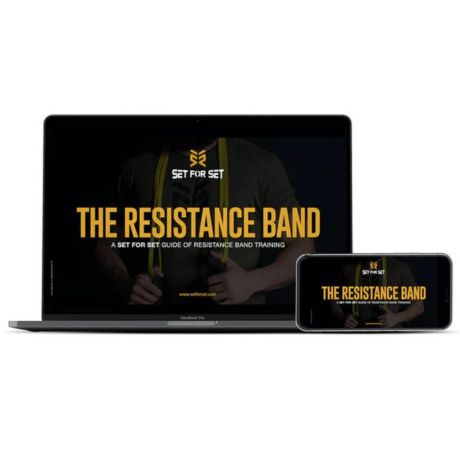Want your perfect workout program?
Take QuizBanded Leg Curl Video Exercise Guide

Written by Garett Reid | NSCA, CSCS, CISSN, M.S.E.S.S
Fact checked by Kirsten Yovino, CPT Brookbush Institute
 FACT CHECKED
FACT CHECKED
The hamstrings, which is made up of three muscles that reside in the back of the upper leg, are essential to having a strong lower body, injury resilient hips and knees, and overall a well-functioning, athletic body.
We all know that training the hamstrings is important. You can do stiff-leg deadlifts, RDLs, hip thrusts, and kettlebell swings to strengthen and build your hamstrings. And, when it comes to isolating the hamstrings, the leg curl machine is great! But what if you don't have access to a leg curl machine or you simply want to switch things up and challenge your muscles in new ways? That's where the banded leg curl comes into play...

A banded leg curl or resistance band leg curl can be done with a simple set up nearly anywhere. All you have to do is loop the band around a stable object like a pole or the foot of your bed frame, and then get into position where resistance is going against knee flexion (curling your legs). You can do this standing, lying or even from a seated position.
As for resistance, the band uses elasticity to create the tension. This means you can create resistance in any direction. The size of the band you use will determine how heavy it is. Moreover, due to the nature of resistance bands, the more it is stretched, the more resistance it has, so you can control the resistance by how taut the band is from the start.
HOW TO DO LYING LEG CURLS WITH RESISTANCE BANDS:
- Begin by anchoring the resistance band to something secure, such as a door or bench.
- Place both feet into the band loop facing away from the door or bar.
- Now, lay face down on your stomach, ensuring the bands remain attached to your ankles.
- Begin curling your legs to your buttock. Ensure that your knees stay on the ground.
- At the top, be sure that you are squeezing your hamstrings for at least two seconds before slowly lowering your feet back down.
- Repeat for 8-12 reps or desired reps.
Here are some other variations of a leg curl using a resistance band:
Single-Leg Lying Leg Curl With Resistance Band
Instead of attaching the band to both of your ankles, you attach it to a single ankle. You can also anchor the band to the opposite ankle if you don’t have something to anchor it to.
Standing Leg Curl With Resistance Band
This is the simplest variation. Put the band just above your ankles and begin lifting your foot against the resistance, alternating sides. Basically you have a low anchor point and you curl your leg as far back as you can toward your butt.
Seated Leg Curl With Resistance Band
Seated leg curls can be done with a chair as long as it has free space for your legs to move. You will anchor the band up above knee height, then loop the band around your ankle. Starting with your legs extended out straight, curl your legs down until your knees are at 90 degrees or less.
Another option is to anchor it up high above you (i.e. a pull up bar), then pull the band down and put your legs through it around your ankles then curl your legs. This would mimic a seated leg curl machine.
BEST SIZE BAND FOR LEG CURLS:
To do leg curls, you will need 41 inch loop resistance bands, which we will go over now...
The band you choose for leg curls will determine the resistance or weight used. 41 inch loop resistance bands start at around 5-10 pounds and go up to 170 pounds, making it perfect for working out at any level of fitness.
The size or resistance level is based on the width of the band, but all bands will have a 41-inch loop. So, the thinner the bands width, the lower the resistance.
If you are a beginner or recovering from an injury, the lightest band will be best for leg curls, but for most, leg curls can be done with light to medium sized bands.
So, for the bands we sell and use, the yellow or black (and maybe the blue if you are strong) will be good for banded leg curls.
Here are the resistance bands we have for reference:
- Yellow - 10 to 35 Pounds 1/2" (Lowest resistance)
- Black - 30 to 60 Pounds 3/4”
- Blue - 40 to 80 Pounds 1.25”
- Green - 50 to 125 Pounds 1.75”
- Gray - 65 to 170 Pounds 2.5"
Buy Resistance Bands from SET FOR SET

COMMON FORM MISTAKES:
- Not Using the Right Weight: Using a heavy band will lead to poor form and can increase your risk of a back injury. Choose a weight that allows you to keep good form. When the weight is too heavy, it forces your body to overcompensate for the heavy weight by lifting your hips and knees off the ground, which you obviously don't want.
- Lifting Knees: Your knees should remain on the ground at all times. If you find that you’re lifting your knees, you may want to reduce the weight you’re using.
- Hips Off The Ground: Push your hips into the ground. This forces the hamstrings to work harder and prevents overworking your lower back.
All in all, you will know if you are doing it right because you will feel tension and muscle engagement directly in your hamstrings, with no low back pain.
WHAT MUSCLES DO BANDED LEG CURLS WORK?
Leg curls are by far the best exercise to isolate, strengthen and develop your hamstrings. Band leg curls will improve your squats and deadlifts, and best of all, shape the back of your legs.
Banded leg curls primarily work your hamstrings. Your hamstrings are the posterior muscles that run between your hip and knee. The three muscles that make up the hamstring muscle group are the semitendinosus, semimembranosus, and biceps femoris.
Depending on the type of leg curls you perform, your hamstrings will be worked a little differently and the range of motion will be greater or less. But in the end, any variation of the leg curl will work all three muscles of the hamstrings because they act on knee flexion, which is what a leg curl is!
BENEFITS OF LEG CURLS WITH BAND:
- Variable Resistance for Max Contraction: Bands have what is called variable resistance, which means as it stretches, the resistance is greater. With that, you can provide maximum resistance at the end range of the curl, which you can't get with dumbbell leg curls. With dumbbell leg curls, which is another common leg curl machine alternative, you will really only have good tension at the starting range, as once you legs come up towards perpendicular with the floor, gravitational force is reduced. As for leg curl machines, you have flat resistance, which means the resistance is even throughout. This is good. But with a band, you can maximize the contraction of the hamstrings even more.
- Eccentric Contraction: Bands naturally produce great eccentric contraction (stretching tension), as you have to resist them flinging you back towards the anchor point. So when you are extending the knees after curling your legs, you will get considerable eccentric contraction, which is great for the overall development of your hamstrings.
- Joint Friendly Reducing Risk of Injury: Using elastic bands reduces the stress on your joints. A banded leg curl provides a natural movement and uses a lower amount of force on the joints without reducing muscle activity. Simply put, you are reducing the risk of potential injury while still building muscles.
- More Variations For Your Home Workout: Unlike machines, resistance band training offers you a variety of options. You can easily isolate your hamstrings with leg curls at home, and you have a variety of options with a single band - seated leg curls, a single-leg leg curl, and lying band leg curl.
- Perfect For Travel: You can’t take your workout equipment with you when you travel, but these bands can easily fit into luggage and come with you when you travel. This makes not missing a workout possible.
Learn how to use bands in every way possible with our resistance band training e-guide...

Our guide has over 250 exercises categorized by mobility, mobilization, resistance training, barbell training, explosive training, static stretching, and (p)rehabilitation...
FINAL THOUGHTS
As you can see, there are many reasons why resistance bands are beneficial - regardless if you’re looking to improve the strength, size, and function of the hamstrings. Banded leg curls target the hamstrings while protecting the joints to reduce injury while stimulating growth and strength. Making it a great option for at home or in the gym exercises.
You can finally isolate your hamstrings at home or in a hotel room without a bulky machine.
Related: Best Leg Curl Alternatives
More Band Resources:
- Banded Glute Kickbacks
- Banded Good Mornings
- Banded Hip Thrusts
- Resistance Band Lunges
- Resistance Band Deadlifts
- Resistance Band Squats
- Resistance Band Rows
- Resistance Band Back Exercises
- Resistance Band Chest Exercises
- Resistance Band Shoulder Exercises
- Resistance Band Triceps Exercises
- Resistance Band Biceps Exercises
- Resistance Band Core Exercises


Also in Blog
Recent Articles
-
All You Need To Know About Cardio WorkoutsApril 14, 2025
-
Calories In, Calories Out Myth: Fact or Fiction?April 08, 2025
-
Cardio Or Strength Training: What's Better For Weight Loss?April 03, 2025
Must Reads
-
Mr Olympia 2024: What to Expect This Year (Oct. 10-13, 2024)September 11, 2024
-
What Can Walking For 1 Hour Everyday Do For You? My ExperienceFebruary 28, 2024
-
The Ultimate "Bro Split" Workout Plan (Backed By Science)August 05, 2023
- Blog
- Exercises
- Workouts
- Meal Plans
- SFS Programs
- Apparel
- About Us
- FAQ
- Shipping
- Warranty
- Contact Us
- Terms & Conditions
- Privacy Policy
- Affiliates
- SFS UGC Policy
- SFS MBG Policy
- Disclosures
- Legal Disclaimer
Sign up to get the latest on sales, new releases and more…
















Garett Reid
Author